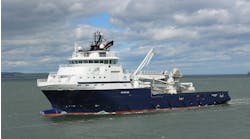Norway hoping for exploration upturn
Norway's Energy Ministry is evaluating bids for 59 North Sea and Norwegian Sea blocks, submitted under its 18th Licensing Round. A total of 95 blocks had been made available, the largest number since licensing started in 1965, in an attempt to revive Norway's flagging exploration sector.
Applications were received from 18 approved companies, notable abstainers including BP and ConocoPhillips. BP had pressed for under-explored basins farther north to be included, but these remain barred to drilling, in deference to local fishermen and environmental lobby groups.
Other majors that did participate in the round also covet Norway's frontier acreage, but must at the same time weigh up the cost of recent deepwater drilling failures. With that in mind, Shell and Statoil recently formed an alliance to explore the deeper sections of the Norwegian Sea.
Another general concern is the slow pace of the country's petroleum tax reforms, given the need to boost discovery rates. Last year, Norsk Hydro was re-awarded North Sea block 171, having relinquished it a short time earlier. Although the block has a highly drillable oil prospect, in touching distance of Hydro's Oseberg platform complex, it would not be worth developing at the current tax rate, the company says.
Increasingly, the government is reaching out beyond the establishment Norwegian shelf operators to independents of all sizes. Its new targets are the mid-size North American companies that have shaken up the UK sector. In February, Energy Ministry officials attended a conference in Houston to press their country's case, claiming that 500 untapped structures had been identified in the Norwegian North Sea alone. Similar campaigns are planned at OTC and ONS Stavanger.
The Norwegian Petroleum Directorate's latest review of the country's resources puts remaining recoverable reserves at 12.9 bcm oil equivalent, a drop of 830 MMcm of oil equivalent on NPD's previous estimate. On the other hand, combined oil, gas, and condensate production on the shelf hit a new peak last year of 263 MMcm.
NPD urges subsea re-think
Most of Norway's newest discoveries and "fallow" fields lie close to platforms or subsea production facilities. Another NPD study has identified 1,000 prospects yet to be drilled, 65% lying in water depths of 400 m or less and within 50 km of land or existing infrastructure. But applying subsea solutions to many of these targets will depend on advances in multiphase flow and subsea separation techniques.
At the recent Underwater Technology Conference in Bergen, NPD's Director General Gunnar Berge said that 40% of the country's production currently comes from subsea-completed wells, with 380 subsea wells in operation. That figure will climb substantially as big projects such as Kristin, Ormen Lange, and Snohvit come onstream.
Two smaller-scale schemes are pending government and partner approval. Statoil has proposed a NKr3.5-billion program to develop its Svale and Staer fields as satellites to the Norne FPSO. Eight subsea wells are planned. Statoil also is looking for new oil in the area via a wildcat well on the Alve prospect.
Marathon has a provisional agreement to convert the multipurpose shuttle tanker Odin to an FPSO, serving as the centerpiece of its first operated Norwegian North Sea development. The Deep Sea Bergen semi has been contracted for at least 10 development wells, taking in the Boa, Kameleon, and Kneler fields under a project known collectively as Alvheim.
Yet another NPD survey, conducted jointly with Statoil and Hydro, found that the recovery factor from Norway's subsea wells was 15-20% lower than from wells with direct platform access.
Oilexco hits Brenda's sweet spot
A small Canadian oil company has made what appears to be Britain's biggest "new" discovery since EnCana's Buzzard. Calgary-based Oilexco's second appraisal well on its Brenda accumulation, in the Outer Moray Firth, flowed 4,785 b/d of 40° oil from Forties Paleocene sandstones. This rate was much healthier than output from the company's first well in January, which was followed by an unsuccessful sidetrack into a neighboring structure, called Sheryl. Reports suggest the company may have a 150 MMbbl field on its hands, not taking into account the results of a third well spudded last month. This well was drilled directionally to a bottom-hole location 1 km to the southwest.
Brenda, in block 15/25b, was originally discovered in 1990, but was assumed to be of low value, and was therefore relinquished. Oilexo picked up the surrounding production license in summer 2002 and proceeded to reprocess existing 3D seismic over this block and nearby block 25/c. Both were considered to hold good prospects for light oil. The company has been approached by Eni about a potential tieback to its Balmoral semisubmersible platform. ;
UK broadens Shetland options
Britain has launched its 22nd offshore licensing round, inviting bids by June 3 for a record 1,039 blocks or part-blocks.
Aside from the re-release of 20 blocks relinquished by previous licensees, the main feature of the round is a new Frontier license, designed to revive activity west of the Shetlands. Incentives include a 90% cut on the normal rental fee for the first two years of this license, and an extended exploration/development envelope. Bidders can also apply for relatively large amounts of acreage in these waters.
Compared with recent seasons, exploratory drilling in this sector was already picking up. Amerada Hess plans to appraise its Cambo prospect – rumored to be a discovery – in blocks 204/9 and 10, just east of Faroese waters. ChevronTexaco may already be drilling two potentially large oil prospects, Rosebank and Lochnagar, in 1,200 ft of water in block 213/27, again close to the median line. And Total should also be under way with its first appraisal well for some while on Laggan, a 1986 gas discovery, 25 km northwest of the Clair field. A successful outcome could spur a new drive for a joint development with other "stranded" gas reserves in the area.
null




